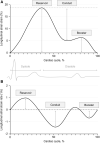Differing Impact of Preterm Birth on the Right and Left Atria in Adulthood
- PMID: 36453643
- PMCID: PMC9851437
- DOI: 10.1161/JAHA.122.027305
Differing Impact of Preterm Birth on the Right and Left Atria in Adulthood
Abstract
Background Preterm birth affects 10% of live births and is associated with an altered left ventricular and right ventricular phenotype and increased cardiovascular disease risk in young adulthood. Because left atrial (LA) and right atrial (RA) volume and function are known independent predictors of cardiovascular outcomes, we investigated whether these were altered in preterm-born young adults. Methods and Results Preterm-born (n=200) and term-born (n=266) adults aged 18 to 39 years underwent cardiovascular magnetic resonance imaging. LA and RA maximal and minimal volumes (absolute, indexed to body surface area, and as a ratio to ventricular volumes) were obtained to study atrial morphology, while LA and RA stroke volume, strain, and strain rate were used to assess atrial function. Secondary analyses consisted of between-group comparisons based on degree of prematurity. Absolute RA volumes and RA volumes indexed to right ventricular volumes were significantly smaller in preterm-born compared with term-born adults. In addition, RA reservoir and booster strain were higher in preterm-born adults, possibly indicating functional compensation for the smaller RA volumes. LA volumes indexed to left ventricular volumes were significantly greater in preterm-born adults as compared with term-born adults, although absolute LA volumes were similar between groups. LA and RA changes were observed across gestational ages in the preterm group but were greatest in those born very-to-extremely preterm. Conclusions Preterm-born adults show changes in LA and RA structure and function, which may indicate subclinical cardiovascular disease. Further research into underlying mechanisms, opportunities for interventions, and their prognostic value is warranted.
Keywords: cardiac remodeling; cardiovascular diseases; magnetic resonance imaging; preterm birth; transitional physiology.
Figures



Similar articles
-
Association of Preterm Birth With Myocardial Fibrosis and Diastolic Dysfunction in Young Adulthood.J Am Coll Cardiol. 2021 Aug 17;78(7):683-692. doi: 10.1016/j.jacc.2021.05.053. J Am Coll Cardiol. 2021. PMID: 34384550 Free PMC article.
-
Association of Systolic Blood Pressure Elevation With Disproportionate Left Ventricular Remodeling in Very Preterm-Born Young Adults: The Preterm Heart and Elevated Blood Pressure.JAMA Cardiol. 2021 Jul 1;6(7):821-829. doi: 10.1001/jamacardio.2021.0961. JAMA Cardiol. 2021. PMID: 33978675 Free PMC article.
-
Myocardial function including estimates of myocardial work in young adults born very preterm or with extremely low birthweight - a cohort study.BMC Cardiovasc Disord. 2023 Apr 29;23(1):222. doi: 10.1186/s12872-023-03253-4. BMC Cardiovasc Disord. 2023. PMID: 37120542 Free PMC article.
-
Acute and chronic cardiac adaptations in adults born preterm.Exp Physiol. 2022 May;107(5):405-409. doi: 10.1113/EP089917. Epub 2022 Mar 9. Exp Physiol. 2022. PMID: 35218678 Free PMC article. Review.
-
Impact of the Vulnerable Preterm Heart and Circulation on Adult Cardiovascular Disease Risk.Hypertension. 2020 Oct;76(4):1028-1037. doi: 10.1161/HYPERTENSIONAHA.120.15574. Epub 2020 Aug 17. Hypertension. 2020. PMID: 32816574 Free PMC article. Review.
Cited by
-
Low birth weight associations with cardiac structure and function in adults after arterial switch for transposition of the great arteries.Int J Cardiol Congenit Heart Dis. 2024 Oct 23;18:100550. doi: 10.1016/j.ijcchd.2024.100550. eCollection 2024 Dec. Int J Cardiol Congenit Heart Dis. 2024. PMID: 39713235 Free PMC article.
-
[The association between preterm birth and hypertension].Zhongguo Dang Dai Er Ke Za Zhi. 2024 Aug 15;26(8):871-878. doi: 10.7499/j.issn.1008-8830.2312129. Zhongguo Dang Dai Er Ke Za Zhi. 2024. PMID: 39148394 Free PMC article. Review. Chinese.
-
Birth weight influences cardiac structure, function, and disease risk: evidence of a causal association.Eur Heart J. 2024 Feb 7;45(6):443-454. doi: 10.1093/eurheartj/ehad631. Eur Heart J. 2024. PMID: 37738114 Free PMC article.
-
Birth Weight Is Associated With Clonal Hematopoiesis of Indeterminate Potential and Cardiovascular Outcomes in Adulthood.J Am Heart Assoc. 2023 Jul 4;12(13):e030220. doi: 10.1161/JAHA.123.030220. Epub 2023 Jun 22. J Am Heart Assoc. 2023. PMID: 37345823 Free PMC article.
-
Whole genome transcriptomics reveal distinct atrial versus ventricular responses to neonatal hyperoxia.Am J Physiol Heart Circ Physiol. 2025 Apr 1;328(4):H832-H845. doi: 10.1152/ajpheart.00039.2025. Epub 2025 Mar 6. Am J Physiol Heart Circ Physiol. 2025. PMID: 40047849 Free PMC article.
References
-
- Chawanpaiboon S, Vogel JP, Moller AB, Lumbiganon P, Petzold M, Hogan D, Landoulsi S, Jampathong N, Kongwattanakul K, Laopaiboon M, et al. Global, regional, and national estimates of levels of preterm birth in 2014: a systematic review and modelling analysis. Lancet Glob Health. 2019;7:e37–e46. doi: 10.1016/S2214-109X(18)30451-0 - DOI - PMC - PubMed
Publication types
MeSH terms
Grants and funding
LinkOut - more resources
Full Text Sources
Medical

